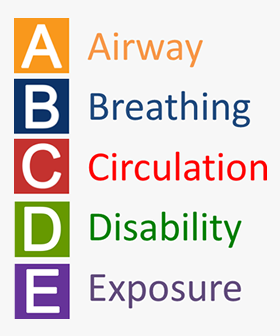ABCDE APPROACH
The RRAPID approach promotes the recognition of patients at risk of acute illness and deterioration followed by the appropriate response. pRRAPID is based on the traditional approach of ABCDE: Airway, Breathing, Circulation, Disability and Exposure. The aim of this standard approach is to recognise any immediate threats to life and respond immediately with appropriate treatments, often before a diagnosis is made. This is called resuscitation. Once resuscitation is complete then a thorough assessment is made to best identify a diagnosis and treat this appropriately.
If the patient is not breathing you should enter the BLS algorithm by giving five rescue breaths, then continue with the standard BLS algorithm, not forgetting to call for help (see Paediatric BLS chapter).

Table: Recognition and Response using ABCDE system
Recognition
- Assess patency by
- Looking for chest and/or abdominal movement
- Listening for breath sounds and
- Feeling for expired air.
- Vocalisations, such as crying or talking, indicate ventilation and some degree of airway patency.
- Paradoxical chest and abdominal movements
- Signs of airway obstruction?
- Foreign body visible?
- Fully obstructed airway will be silent
- Cyanosis/hypoxia is a late sign
Response
- Call for help if signs of airway obstruction
- Basic airway manoeuvres
- Older child: Head tilt, chin lift
- Infant: neutral position
- Jaw thrust
- Airway adjuncts
- Oropharyngeal airway
- Nasopharyngeal airway
- Suction secretions (Yankauer)
- Give oxygen (O2)
- Call an anaesthetist for definitive airway management
Recognition
Effort of breathing:
- Respiratory rate
- Recessions
- Accessory muscle use
- Flaring of nostrils
- Inspiratory and expiratory noises: wheeze, stridor, and crepitations?
- Grunting
- Posture/position
Efficacy of breathing
- Equal air entry?
- Percussion note
- Trachea central?
- Gasping?
- SpO2 in air
- Chest movement
Effect on body:
- Heart rate
- Capillary refill
- Conscious level
Response
- If not breathing- ventilate with a bag-valve mask (BVM) device
- Give O2 sub>15 L/min via a non-rebreathe mask with reservoir bag
- Aim O2 saturations 94-98%
- Blood gas (ABG) – usually performed venously or capillary in infants and small children
- Chest X-ray (CXR)
- Site a nasogastric tube (especially if using a BVM)
Recognition
- Vital signs
- Heart rate
- Pulse volume
- Blood pressure
- Skin & mucous membrane perfusion:
- Capillary refill time (central & peripheral)
- Skin temperature
- Skin colour
- Organ Perfusion:
- Effects on breathing
- Mental status
- Urine output
Response
- Intravenous access. (Intraosseous needle if cannulation not rapidly established). Take blood for blood gas (including lactate and ionised calcium), glucose stick test and laboratory tests including full blood count (FBC), urea & electrolytes (U&Es), renal and liver function, CRP, blood culture, cross-match & coagulation studies, (consider an ammonia level).
- 3-lead cardiac monitoring and/or a 12-lead ECG.
- Fluid bolus (mls/kg) and assess response
Recognition
- Patient response: alert, verbal, pain, unresponsive (AVPU)
- Pupils - size and reaction to light
- Posture
- Blood glucose
- Evidence of seizure activity?
Response
- Protect airway
- Endotracheal tube if GCS < 8 (call for anaesthetic help)
- Recovery position if airway not protected
- Give glucose if hypoglycaemia (glucose < 3 mmol/L)
- Treat seizure activity with benzodiazepines
Recognition
- Expose the patient (maintain dignity and minimise heat loss) to assess for injuries, signs of infection, bleeding etc.
- Check temperature & review physiological markers
- Full history and examination (where time and clinical condition allows)
- Drug & fluid chart review
- Investigation results
Response
- Senior/expert medical advice
- Management plan
- Documentation
- Communication (SBARR)
- Organise transfer to High Dependency Unit (HDU)/Intensive Care Unit (ICU) if appropriate





